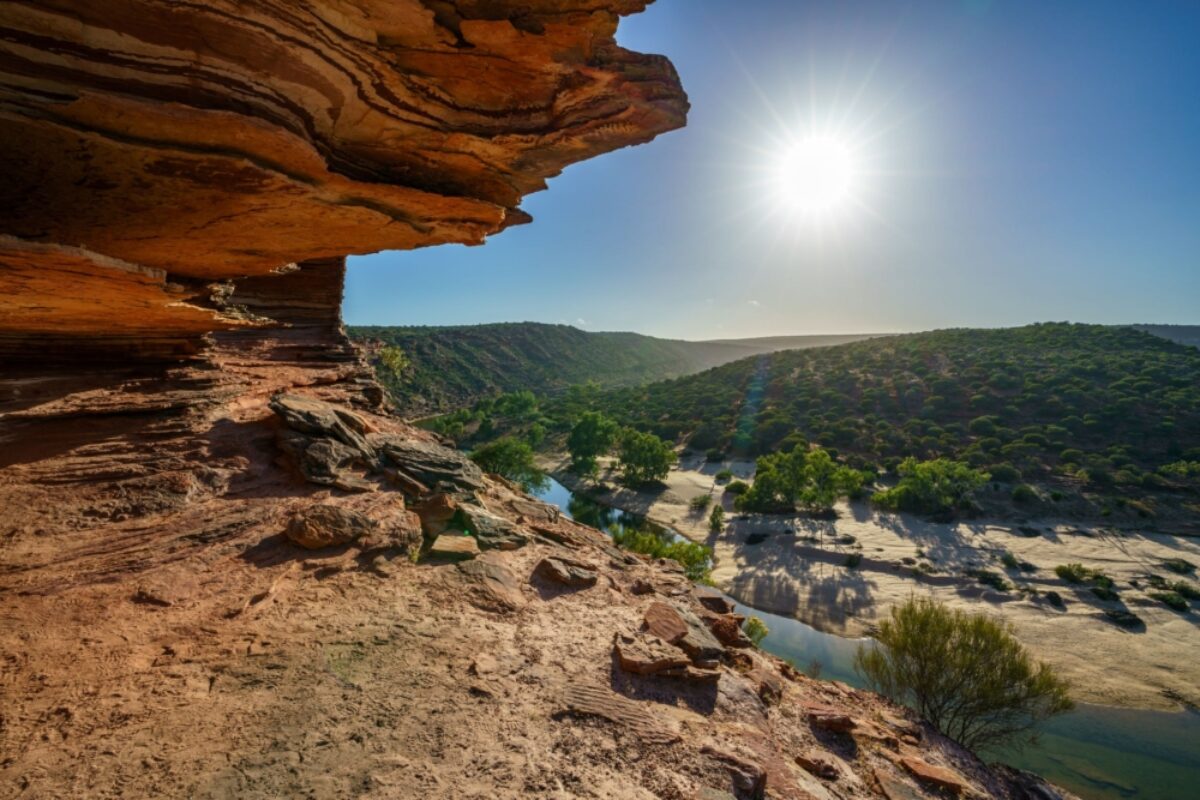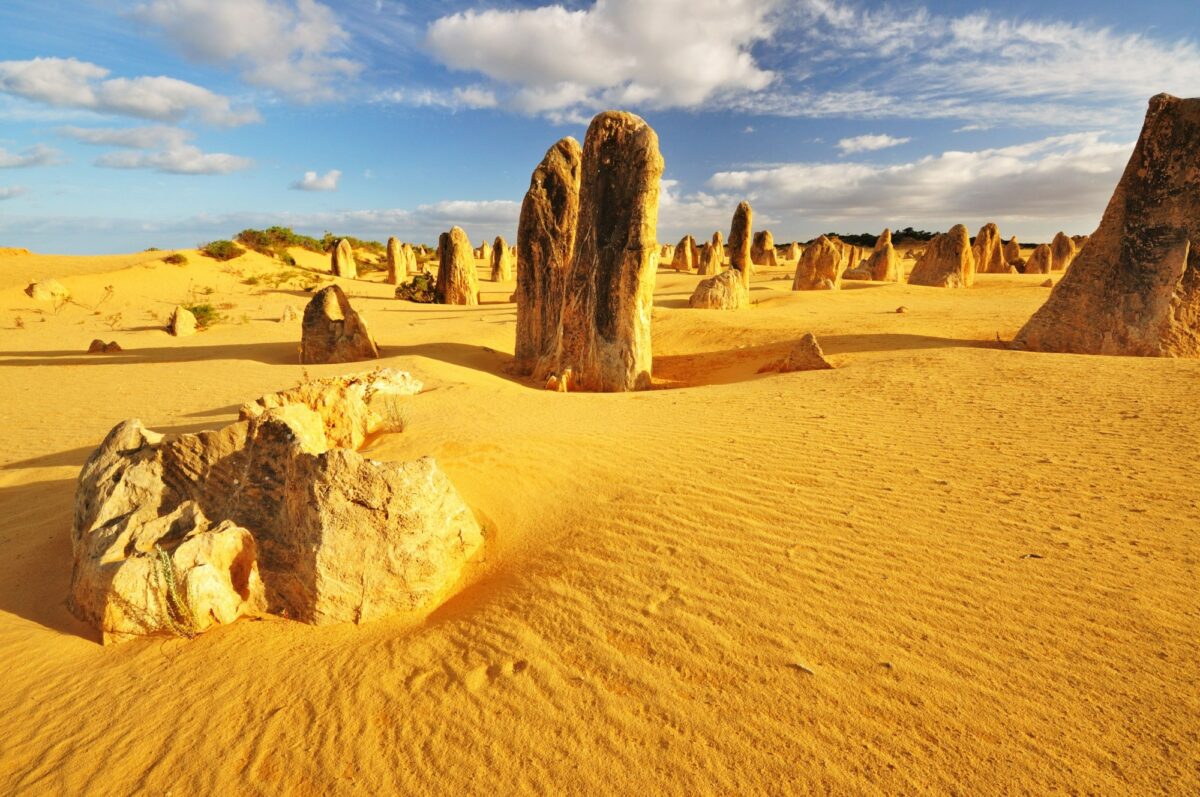Coral Coast Road Trip Route
Australia's lesser-visited coastal drive
Western Australia is virtually empty of people. Long stretches of white sand beaches, hiking paths through cavernous gorges and vast coral reefs alike. Driving the Coral Coast route from Perth to Exmouth, you’ll see the best coastlines Australia has to offer with virtually no other visitors there to block the view.
Coral Coast road trip
Approx. distance: 1,600km (995 miles) (one way)
Duration: At least five to six days
Suggested route: Perth—Lancelin—The Pinnacles—Hutt Lagoon—Kalbarri—Shark Bay—Coral Bay—Exmouth.

Hiking in Kalbarri National Park, north of Perth
Coral Coast road trip itinerary
Spend at least five to six days on this route, broken up into the following suggested sections:
Stage one: Perth to Lancelin (122km, one to two hours)
Stage two: Lancelin to The Pinnacles (95km, one hour)
Stage three: The Pinnacles to Hutt Lagoon (383km, four hours)
Stage four: Hutt Lagoon to Kalbarri (55km, 30 minutes)
Stage five: Kalbarri to Shark Bay (304km, three hours)
Stage six: Shark Bay to Coral Bay (486km, five hours)
Stage seven: Coral Bay to Exmouth (153km, two hours)

The Pinnacles Desert, north of Perth
Highlights on the Coral Coast road trip
The Turquoise Coast, Perth to Kalbarri
Setting out from Perth, it takes only a couple of hours before you’ll find yourself in absolute isolation. Lancelin is one of the first towns you’ll hit, a place to refuel, grab a coffee or, if you’re feeling adventurous, throw yourself down a sand dune. Renting a board in town, crowds regularly travel up from Perth to sandboard down the Lancelin dunes.
Nearby, the Pinnacles National Park is home to one of WA’s most bizarre geographic landforms. Stacked for miles along the golden desert, the 20,000-year-old remnants of the former seafloor still stand. Take an hour or to wander between the thousands of statues, to drive the scenic road between the dunes, and to take a look at the local wildlife displays on site. These will give you an idea of which critters to look for, and which to avoid, for the rest of your trip.
Further north, near the small town of Gregory, sits one of many strange lakes in Western Australia. You can spot the bright pink Hutt Lagoon before you even see the water, as the clouds above it tinted rosy in the reflection. The lake is pretty and unusual but doesn’t need a long stop to see.
The highlight of this first stretch of western coast is, undoubtedly, Kalbarri National Park. Veer off the highway when you spot the viewpoint markers dotted along the roadside, particularly at Red Bluff or Mushroom Gorge, where you’ll meet panoramic views over dramatic rocky cliffs and thrashing waves. Keep an eye out for humpback whales (May-Dec) and the dolphins that routinely jump alongside the surfers.
Inland, start out taking the short walk up to Nature’s Window lookout. The walk takes only 15-20 minutes, leading visitors out to panoramic views across the river gorge at the park’s most iconic spot. The other hikes through the park require a moderate level of fitness, and take significantly longer, where you’ll shimmy down ladder between towering rocks, skip across rivers filled with fish and fossils, and dodge spiderwebs clinging to ancient caves. If you’re interested, try the Loop or the Z bend.
Shark Bay
Shark Bay lives up to its name. Just sit and watch the water and you’ll see tiger sharks, manta rays, dolphins and turtles. Further out to sea, you’ll find dugongs -- manatee-like mammals native only to Australia’s west coast. Head for Denham, the largest town in the area. Here, a campsite with facilities and barbecues, a gas station, pubs, coffee shops, restaurants and a museum make it an exciting change from the au natural beach campsites found along the road.
Monkey Mia is the most tourist-friendly spot on Australia’s west coast. There are luxury hotels, nice restaurants, and crowds. The visitors are driven by the park’s main attraction, playful, shallow-dwelling dolphins. Each morning the park run ‘meet & greets’, where staff will feed the dolphins that have lived along the coast for years, and visitors will have an opportunity to join it.
To get away from the crowds, set out to sea. Weaving around the families of emus that hang out on the beaches, you organise tours to watch rays, sharks, dolphins, turtles and dugongs. Provided you aren’t there on a very busy day, if you’re taking a midday snorkelling tour, you can typically ask to join the sunset excursion for free.
Between Monkey Mia and Denham roll the red sand dunes of Francois Peron National Park. Accessing the park requires a 4WD, and the entrance and exit are marked by spots to let down your tires. Once you have, you’re in for a wild off-road ride out to Big Lagoon, where bright blue water, stark orange shores, and the occasional dusty kangaroo stand in contrast.
Back at the coast, you should head to Shell Beach. From a distance, the beach looks like it’s lined by eerily pristine white sand. Up close, you’ll find that it’s made up of millions of minuscule shells. This curious phenomenon is neighboured by another of Australia’s oldest and strangest sites, the stromatolites at Hamelin Pool. A collection of the oldest and largest living fossils on earth, you’ll get a glimpse into what the planet’s waters looked like 3.7 billion years ago when stromatolites grew widespread across the world. Only four places in the world have similar fossils, with these being by far the largest.
The Ningaloo Reef, Coral Bay to Exmouth
As the Great Barrier Reef falls prey to climate change, industrial over-fishing and overtourism, the Ningaloo is considered by many the greatest coral reef in Australia today. It’s the world’s largest fringing reef, home to hundreds of species of fish, mammals and coral.
When stepping into the sea at Coral Bay, you have to be careful. From the shallowest tides, the seabed is filled with healthy and vibrant coral. Inches from the shore you can find yourself swimming with giant tropical fish, rays and turtles, all living harmoniously in the expansive reef.
Attracting many visitors, there are plenty of accommodation options close to the beach in the small town at Coral Bay.
Exmouth, a relatively large town surrounded by national parks and empty beaches, is an ideal base from which to explore more of the Ningaloo. From October to February, you’ll have a chance to see giant sea turtles come ashore to lay their eggs, or even a chance to watch the babies hatching. Travel to regulated stretches of coastline late at night, and wait as more and more turtles clamber ashore. The process is slow, and visitors are asked to avoid shining lights or making too much noise, but being present is an incredible experience.
Exmouth is right next to Cape Range national park, where you can re-familiarise yourself with the marine life, and even ride a rip-tide in a safe and controlled environment. Further from shore, joining one of the deeper sea snorkel or diving trips, you can swim with manta rays, reef sharks and gentle, giant whale sharks (March-July).
A surprising star of the show, far away from the famed beauty of the national parks, sits just outside the town of Carnarvon. You’ll pass the town on your way to Exmouth, but don’t write it off as a quick fuel stop.
Ferocious waves push through battered rocks along the coastal cliffs, bringing enormous and forceful bursts of sea through the coastal blowholes. Very few visitors venture out to the blowholes, but they’re a popular sight amongst locals. You can only see them at high tide, so search the tidal times in advance for the day you plan to travel.
A few minutes drive uphill from the blowholes, the Carnarvon lighthouse offers a scenic spot to stop and watch the sunset. Clear skies and dramatic colours show off the western title of ‘the Sunset Coast’.




